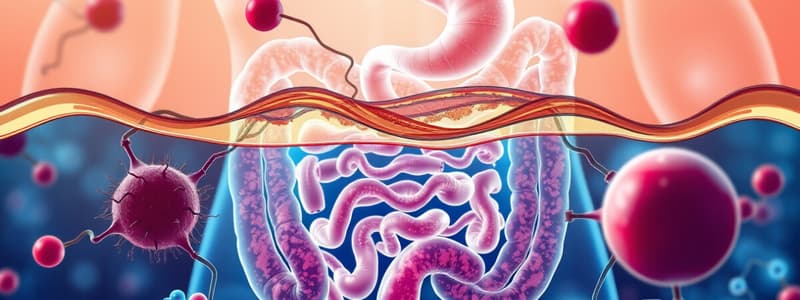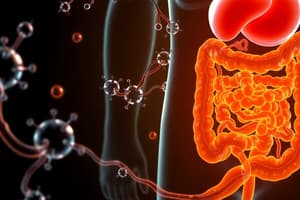Podcast
Questions and Answers
Which of the following is an essential role played by large intestine bacteria? (Select all that apply)
Which of the following is an essential role played by large intestine bacteria? (Select all that apply)
- Produce gas
- Synthesize vitamin K and B-complex vitamins (correct)
- Absorb bilirubin
- Synthesize vitamins C and D
Pepsinogen, a digestive enzyme, is secreted by the ________.
Pepsinogen, a digestive enzyme, is secreted by the ________.
chief cells of the stomach
How are most nutrients absorbed through the mucosa of the intestinal villi?
How are most nutrients absorbed through the mucosa of the intestinal villi?
- Facilitated diffusion
- Active transport (correct)
- Bulk flow
- Simple diffusion
The digestive function of the liver is to produce bile.
The digestive function of the liver is to produce bile.
The longest portion of the small intestine is the _______.
The longest portion of the small intestine is the _______.
The chemical and mechanical processes of food breakdown are called ________.
The chemical and mechanical processes of food breakdown are called ________.
A baby is admitted to the hospital with projectile vomiting. Because of the baby's loss of gastric juice, his blood probably indicates ________.
A baby is admitted to the hospital with projectile vomiting. Because of the baby's loss of gastric juice, his blood probably indicates ________.
Choose the incorrect statement regarding bile.
Choose the incorrect statement regarding bile.
Which vitamin requires intrinsic factor in order to be absorbed?
Which vitamin requires intrinsic factor in order to be absorbed?
The chief bile pigment is ______.
The chief bile pigment is ______.
Hydrochloric acid is secreted by which of the secretory cells of the stomach?
Hydrochloric acid is secreted by which of the secretory cells of the stomach?
There are three phases of gastric secretion. The cephalic phase occurs ________.
There are three phases of gastric secretion. The cephalic phase occurs ________.
Which of the following enzymes is specific for proteins?
Which of the following enzymes is specific for proteins?
Pepsinogen is the precursor to the gastric enzyme for protein digestion and is secreted by the parietal cells.
Pepsinogen is the precursor to the gastric enzyme for protein digestion and is secreted by the parietal cells.
The ingestion of a meal high in fat content would cause which of the following to occur?
The ingestion of a meal high in fat content would cause which of the following to occur?
Which of the following is not a factor that helps create the stomach mucosal barrier?
Which of the following is not a factor that helps create the stomach mucosal barrier?
The principal enzyme for breaking down carbohydrates is ________.
The principal enzyme for breaking down carbohydrates is ________.
The absorptive effectiveness of the small intestine is enhanced by increasing the surface area of the mucosal lining. Which of the following accomplishes this task?
The absorptive effectiveness of the small intestine is enhanced by increasing the surface area of the mucosal lining. Which of the following accomplishes this task?
The ________ phase of gastric secretions occurs when food enters the stomach.
The ________ phase of gastric secretions occurs when food enters the stomach.
Digestion of which of the following would be affected the most if the liver were severely damaged?
Digestion of which of the following would be affected the most if the liver were severely damaged?
From the esophagus to the anal canal, the walls of every organ of the alimentary canal are made up of the same four basic layers. Arrange them in order from the lumen.
From the esophagus to the anal canal, the walls of every organ of the alimentary canal are made up of the same four basic layers. Arrange them in order from the lumen.
In addition to storage and mechanical breakdown of food, the stomach ________.
In addition to storage and mechanical breakdown of food, the stomach ________.
You have just eaten a meal high in complex carbohydrates. Which of the following enzymes will help to digest the meal?
You have just eaten a meal high in complex carbohydrates. Which of the following enzymes will help to digest the meal?
The pancreas has both an endocrine and an exocrine function.
The pancreas has both an endocrine and an exocrine function.
When we ingest large molecules such as lipids, carbohydrates, and proteins, they must undergo catabolic reactions whereby enzymes split these molecules. This series of reactions is called ________.
When we ingest large molecules such as lipids, carbohydrates, and proteins, they must undergo catabolic reactions whereby enzymes split these molecules. This series of reactions is called ________.
Study Notes
Digestive System Key Concepts
- Large intestine bacteria play a crucial role in synthesizing vitamin K and B-complex vitamins.
- Pepsinogen, a precursor to pepsin, is secreted by chief cells of the stomach.
- Nutrient absorption in the intestinal villi primarily occurs through active transport mechanisms.
- The liver's main digestive function is bile production, which aids in emulsifying fats.
- The ileum is the longest section of the small intestine.
- Digestion encompasses both chemical and mechanical processes involved in breaking down food.
Acid-Base Balance and Enzymes
- A baby with projectile vomiting likely experiences alkalosis due to loss of gastric juice.
- Bile has several functions, including carrying bilirubin and emulsifying fats, but does not contain digestive enzymes.
Vitamins and Bile
- Intrinsic factor is essential for the absorption of vitamin B12.
- Bilirubin serves as the principal bile pigment.
- Hydrochloric acid is secreted by parietal cells in the stomach.
Gastric Secretion Phases
- The cephalic phase of gastric secretion is triggered by the aroma, sight, or thought of food before it enters the stomach.
- The gastric phase occurs when food is present in the stomach, stimulating further secretion.
Enzymatic Actions
- Trypsin is a specific enzyme for protein digestion.
- Pepsinogen is not secreted by parietal cells but by chief cells.
- A high-fat meal triggers bile release from the gallbladder for fat emulsification.
- The principal enzyme for carbohydrate breakdown is amylase.
Structural Adaptations and Digestive Processes
- The absorptive capacity of the small intestine is significantly enhanced by circular folds, villi, and microvilli.
- The alimentary canal is constructed from four basic layers: mucosa, submucosa, muscularis externa, and serosa, arranged from the lumen outward.
- The stomach initiates protein digestion and denatures proteins, but is not the primary site for absorption.
Digestion Needs and Pancreas Function
- Severe liver damage significantly impacts lipid digestion.
- The pancreas functions both endocrinely (hormone secretion) and exocrinely (enzyme secretion).
- Catabolic reactions that break down large molecules during digestion are classified as chemical digestion.
Studying That Suits You
Use AI to generate personalized quizzes and flashcards to suit your learning preferences.
Description
Test your knowledge on the key concepts of the digestive system and its functions. This quiz covers digestion processes, the role of bile, nutrient absorption, and important vitamins. Explore the intricate balance of enzymes and acid-base dynamics within the digestive system.




